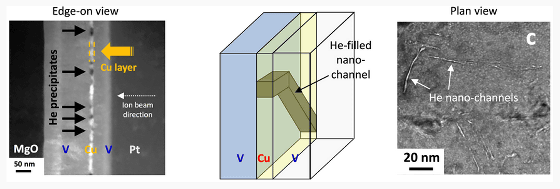A structure that solves the biggest barrier of fusion power generation "metal embrittlement caused by helium bubbles" is discovered for the first time

Research is being advanced as a next generation energy sourceNuclear fusionDiscovery that advances technology one step further is brought. From the research conducted mainly by Texas A & M University in the USA, the problem that the metal material which became a major obstacle to nuclear fusion power generation technology is fragile ("metal embrittlement by helium bubble") We found a structure with high resistance to.
Self-organization of helium precipitates into elongated channels within metal nanolayers | Science Advances
http://advances.sciencemag.org/content/3/11/eaao2710
Channeling helium: Researchers take next step toward fusion energy | 10 | 11 | 2017 | News & Events | College of Engineering
http://engineering.tamu.edu/news/2017/11/10/channeling-helium-researchers-take-next-step-toward-fusion-energy
A Helium-Resistant Material Could Usher in the Age of Nuclear Fusion
https://futurism.com/helium-resistant-material-usher-nuclear-fusion/
In nuclear fusion power generation, electricity is generated based on the very large energy generated when light atoms such as hydrogen and helium collide and merge. Strong radiation is emitted when the nucleus fuses, but in principle radiation release will be zero as soon as the reaction stops. For this reason, nuclear fusion power generation is also called "energy source of dreams" because there is no primary nuclear waste such as plutonium in nuclear power generation.
One of the obstacles to such nuclear fusion power generation is the problem of metal embrittlement caused by helium bubbles. This is because helium, which is a byproduct produced during the nuclear fusion reaction of hydrogen atoms, generates fine bubbles "helium bubbles" in the portion close to the surface of the metal, thereby bringing the metal into a sponge-like state, It would make the state like a fiber that was finally a very fragile metal. Therefore, the development of metals and their structures that can be used in reactors that require high pressure-resistant performance is an issue.
The breakthrough that cleared the "metal embrittlement" this time was discovered by Texas A & M UniversityLos Alamos National LaboratoryIt is a research team by. In order to solve the metal embrittlement problem, the research team investigated the change of helium bubble formation by the new structure. Then, it was discovered that if a metal layer generated at the nano level is provided, the generated helium bubbles are connected one after another, resulting in a phenomenon of "self-growing" in the form of a tunnel. It looks almost like a blood vessel of a living being, Professor Michael Demkowicz of Texas A & M University says, "We were overwhelmed by the things we saw, and helium got into the nano-sized structure steadily When given, it does not destroy the metal material as in the past, instead the tunnels that occurred are connected one after the other to create a blood vessel-like structure. "

The figure below illustrates the growth. A phenomenon that a helium bubble occurs in a band-shaped part (B), a bubble gradually grows linearly (C), and finally it forms a pipe-like structure (D) has been confirmed .

According to Demkowicz, based on this result, it is first thought that it is the formation of a structure that allows helium to escape to the outside. Although the main material so far was focused on keeping helium inside, there is a possibility to think of a solution of releasing it to the outside by passing helium through the generated tunnel.
In addition, it is thought that a mechanism to "self-recover" the material by sending heat, electricity, or specific chemical substances into the tunnel that occurred afterwards. In other words, it is expected to establish innovative technology that organizations like organisms in living organisms are constructed in metal.
Related Posts:
in Science, Posted by darkhorse_log







